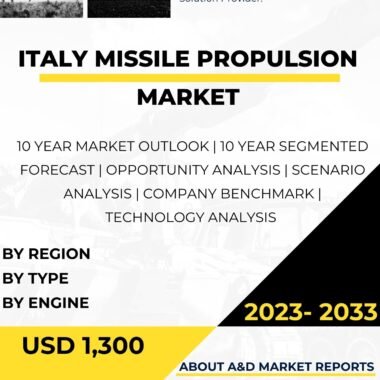Description
The missile propulsion market in Japan has seen significant growth and strategic importance as the nation focuses on enhancing its defense capabilities and strengthening its military posture in response to evolving security challenges in the Indo-Pacific region. Missile propulsion is a critical aspect of missile development, directly influencing a missile’s range, speed, and overall performance. As Japan seeks to bolster its deterrence capabilities and address regional security concerns, the demand for advanced missile propulsion technologies has grown, leading to increased research, development, and investment in this field.
Missile propulsion technologies in Japan encompass a wide range of systems, including solid-fuel propulsion, liquid-fuel propulsion, and hybrid propulsion systems. Each of these propulsion technologies offers distinct advantages and is suited for different types of missiles and operational requirements.
One of the primary applications of missile propulsion in Japan is in ballistic missiles. These missiles rely on powerful propulsion systems to achieve high speeds and altitude during their flight trajectory. Japan’s development of ballistic missile technology has been driven by the need to deter potential adversaries and counter regional security threats effectively.
Moreover, missile propulsion is also crucial for cruise missiles. These missiles require sustained propulsion to fly at lower altitudes and follow complex flight paths, allowing them to evade enemy defenses and precisely strike their targets. Cruise missiles provide Japan with a flexible and long-range strike capability to address potential threats or respond to emerging security challenges.
Additionally, missile propulsion technologies are essential for surface-to-air missiles (SAMs) and surface-to-surface missiles (SSMs). These missiles must have sufficient propulsion power to engage and intercept airborne and surface targets effectively. SAMs provide Japan with a robust air defense capability, while SSMs contribute to its naval and coastal defense posture.
As Japan emphasizes indigenous defense capabilities, the domestic production and development of missile propulsion technologies have seen substantial growth. Collaborations between the government, defense industry, and research institutions have fostered innovation, leading to the creation of advanced missile propulsion systems tailored to Japan’s specific defense requirements.
Japan’s alliance with the United States has also played a significant role in the development of its missile propulsion capabilities. Through this partnership, Japan has access to advanced technologies and expertise, contributing to the modernization of its defense forces and enhancing interoperability with allied nations.
The missile propulsion market in Japan also benefits from advancements in materials science, propulsion technology miniaturization, and precision manufacturing. Manufacturers have leveraged these developments to create propulsion systems with higher thrust-to-weight ratios, improved reliability, and reduced size and weight.
However, the missile propulsion market in Japan also faces challenges related to range, fuel efficiency, and cost. Increasing the range of missiles requires more powerful propulsion systems and larger fuel loads, leading to potential challenges in terms of platform size and cost.
Improving fuel efficiency is crucial for increasing missile endurance and operational flexibility. Advancements in propulsion technology and fuel composition can contribute to achieving this objective.
Developing and maintaining advanced missile propulsion systems can be costly, requiring significant investment in research, development, production, and testing.
Addressing these challenges is crucial for further enhancing Japan’s missile propulsion capabilities and ensuring that the nation’s missile systems remain effective, reliable, and capable of countering evolving security threats.
In conclusion, the missile propulsion market in Japan has witnessed significant growth and strategic importance, driven by the nation’s focus on enhancing its defense capabilities and strengthening its military posture in response to evolving security challenges. Missile propulsion technologies provide critical capabilities for ballistic missiles, cruise missiles, SAMs, and SSMs, making them integral to Japan’s defense strategy. The collaboration between the government, defense industry, and research institutions, as well as international partnerships with allied nations, fosters innovation and contributes to the growth of the domestic missile propulsion market. Addressing challenges related to range, fuel efficiency, and cost is crucial for further enhancing Japan’s missile propulsion capabilities and ensuring that the nation’s missile systems remain at the forefront of defense technology, providing an effective deterrent and response capability in the face of regional security challenges. With its strategic focus on enhancing indigenous defense capabilities, Japan remains committed to leveraging advanced missile propulsion technologies to enhance its defense capabilities and contribute to regional and global security.




